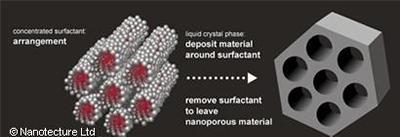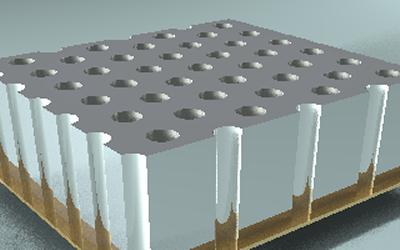Chemistry Spin-out wins Frost & Sullivan’s European Union Technology Innovation Award

Nanotecture Ltd, a spin-out from Chemistry, has won Frost & Sullivan’s 2010 European Union Technology Innovation Award in Nanomaterials. Nanotecture was founded in 2003 to exploit fundamental research on lyotropic liquid crystal templating of nanostructured materials carried out in Chemistry with funding from EPSRC by Professors Attard, Bartlett and Owen.
Nanotecture was selected for the award, from a pool of 50 companies, for its unique nanoporous metals which are used to improve energy storage devices. Key to winning the award was the uniqueness of the technology, the impact on functionality and the relevance of the innovation to the energy industry.
Nanotecture’s innovation adopts an efficient nanopore technology, which makes it easier to manufacture and handle than other nano-particle and nano-sized material technologies. Nanoporous materials have a high surface area, vastly improving performance in a supercapacitor electrode, resulting in an asymmetric supercapacitor design that is capable of delivering more energy at higher powers when compared to a standard electrochemical capacitor.

Bill Campbell, Chief Executive Officer of Nanotecture, commented: “Nanotecture’s innovation comes at a time when a technological juncture of nanotechnology, material science, and energy storage is emerging. Our core technology also supports the production of nonporous materials in different forms including thin-film, monolithic, powder, and discrete particles, allowing for applications such as thin-film sensors and microelectrodes. The implications of our work are vast and I am delighted that this has been recognised by Frost & Sullivan. “
Christina Priya Dhanuja, Senior Analyst at Frost & Sullivan said: “World over, the need to find efficient ways of storing energy for cleaner production and consumption is higher than ever. There has thus been a significant number of research developments reported within the domain of material science. In this context, Nanotecture's proprietary low-cost nanoporous material production process, which results in the controlled synthesis of nanoscale structures within materials, is a noteworthy development. These nanoporous materials have very high-surface areas, as high as hundred times the area of the equivalent nonporous material. When used to make a supercapacitor electrode, this material ensures a high-speed response and high-power density”.
For further information, please visit http://www.nanotecture.co.uk/home.aspx